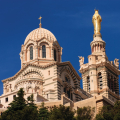NOTRE-DAME-DE-LA-GARDE BASILICA
This famous basilica, dedicated to Notre-Dame de la Garde, protector of the city, dominates the city and the bay of Marseille.
It's the city's symbol par excellence. Visible from all 4 corners of Marseille, the "Bonne Mère" is a cherished monument for the people of the city, who flock to it from childhood onwards, to light a candle and admire the view. The basilica is also very popular with visitors of all faiths and origins. The belvedere surrounding the basilica offers a breathtaking view of the surrounding area, from the Calanques massif to the port, which will convince even the least devout among us. Climbing the steps from the parking lot is difficult, especially in summer, and can feel like a pilgrimage. But a visit to the Good Mother is an absolute must in Marseille!
Omnipresent in the lives of Marseillais, the Basilica dominates the city and pops up around every corner. Wherever you are, you can't escape it; like a lighthouse, it watches over Marseille and protects its inhabitants. The history of this monument is intimately linked to that of the city. The old lady was built in the 19th century, but the hill on which it stands became an important spiritual site as early as the 12th century: the first chapel dedicated to the Virgin Mary was erected on this rocky outcrop in 1214, in accordance with the wishes of a Marseille priest. It was already a favorite place of devotion for the people of Marseilles, so much so that the chapel was soon too small to accommodate the many faithful who flocked there. For this reason, the original building was replaced by a larger chapel in the 15th century. Rising 147 m above the town, it then became a military stronghold under Francis I , who observed during a visit to the chapel that the town was poorly defended. In the 19th century, the aging sanctuary proved too small to accommodate all its visitors. Monseigneur de Mazenod decided to build a much larger structure on top of the existing edifice. At the time, Marseille was in the midst of a major redevelopment project. Work, entrusted to the architect Espérandieu, began in 1853. At the end of the Second World War, the Basilica of Notre-Dame-de-la-Garde played an important role in the liberation of Marseille. On August 24, 1944, General de Monsabert gave the order to seize the hill of Notre-Dame-de-la-Garde, a strategic location where German troops were entrenched. But the site was well guarded, and German fire made access difficult. To enter the basilica, the Algerian riflemen, who were on the front line, were guided by a Marseilles resistance fighter who took them along a circuitous route, unknown to the Germans, leading to the Cherchel plateau from what is now rue Jules-Moulet. The Algerian riflemen succeeded in storming the hill, entering the basilica and raising the tricolor flag to the top of the bell tower. An immense clamor arose from the four corners of the town. The fighting wasn't over yet, but the liberation of the Bonne Mère gave Marseillais renewed hope. Even today, bullet holes and shrapnel, the sad remains of this bloody battle, can be seen on the basilica's façade.
Like the Cathedral de la Major, the basilica is in typical Romanesque-Byzantine style. The building comprises a lower church, which houses the crypt, and an upper church decorated with mosaics and dedicated to the Virgin Mary. Don't miss
The vaulted crypt, entirely carved out of the rock in Romanesque style, with its austere, uncluttered decor. The first mass was celebrated here in 1861, several years before the work was completed. Comprising a vaulted nave flanked by six side chapels, it houses a polychrome crucifix (16th century) and a mater dolorosa by sculptor Carpeaux. From an ornamental point of view, the contrast between the crypt and the upper church, accessed by side staircases, is very striking.
The upper church is less impressive for its dimensions (the nave is 32 m long and 14 m wide) than for its sumptuous decoration. The ceilings and side walls of the basilica are adorned with mosaics: a total of some 12 million tesserae in all colors cover a surface area of 2,500m2. The Byzantine mosaic tesserae were produced by Venetian craftsmen in the late 19th century. With its alternating panels of ceramic, red marble and white Carrara marble, the upper church boasts an extraordinarily rich chromatic decor. Look up to admire the vaulted ceiling with its impressive gilding and detailing.
The ex-voto collection. The Basilica's ex-voto collection, whose tradition dates back to the 14th century, has become a curiosity over the years. In the Christian religion, these objects are offerings of thanks for a grace obtained through prayer. Notre-Dame-de-la-Garde is said to be home to over 2,500 of them, which have overflowed from the basilica into the crypt and forecourt. Note the multitude of small boats hanging from the church's vaults, offerings from sailors returning safely from their sea voyages. The ex-votos also take the form of small paintings on which scenes have been depicted.
Did you know? This review was written by our professional authors.
The strengths of this establishment:
Members' reviews on NOTRE-DAME-DE-LA-GARDE BASILICA
The ratings and reviews below reflect the subjective opinions of members and not the opinion of The Little Witty.















En dehors de l'architecture unique la cathédrale inspire une sacralité rare.
ex voto, mosaiques, chapelles sont à voir. .